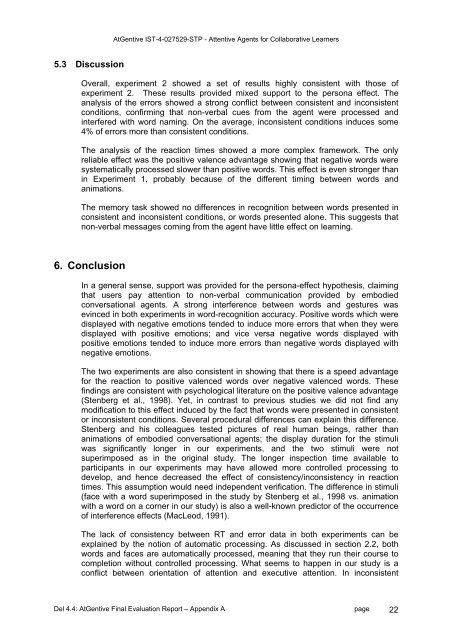Deliverable 4.4 - INSEAD CALT
Deliverable 4.4 - INSEAD CALT
Deliverable 4.4 - INSEAD CALT
Create successful ePaper yourself
Turn your PDF publications into a flip-book with our unique Google optimized e-Paper software.
AtGentive IST-4-027529-STP - Attentive Agents for Collaborative Learners5.3 DiscussionOverall, experiment 2 showed a set of results highly consistent with those ofexperiment 2. These results provided mixed support to the persona effect. Theanalysis of the errors showed a strong conflict between consistent and inconsistentconditions, confirming that non-verbal cues from the agent were processed andinterfered with word naming. On the average, inconsistent conditions induces some4% of errors more than consistent conditions.The analysis of the reaction times showed a more complex framework. The onlyreliable effect was the positive valence advantage showing that negative words weresystematically processed slower than positive words. This effect is even stronger thanin Experiment 1, probably because of the different timing between words andanimations.The memory task showed no differences in recognition between words presented inconsistent and inconsistent conditions, or words presented alone. This suggests thatnon-verbal messages coming from the agent have little effect on learning.6. ConclusionIn a general sense, support was provided for the persona-effect hypothesis, claimingthat users pay attention to non-verbal communication provided by embodiedconversational agents. A strong interference between words and gestures wasevinced in both experiments in word-recognition accuracy. Positive words which weredisplayed with negative emotions tended to induce more errors that when they weredisplayed with positive emotions; and vice versa negative words displayed withpositive emotions tended to induce more errors than negative words displayed withnegative emotions.The two experiments are also consistent in showing that there is a speed advantagefor the reaction to positive valenced words over negative valenced words. Thesefindings are consistent with psychological literature on the positive valence advantage(Stenberg et al., 1998). Yet, in contrast to previous studies we did not find anymodification to this effect induced by the fact that words were presented in consistentor inconsistent conditions. Several procedural differences can explain this difference.Stenberg and his colleagues tested pictures of real human beings, rather thananimations of embodied conversational agents; the display duration for the stimuliwas significantly longer in our experiments, and the two stimuli were notsuperimposed as in the original study. The longer inspection time available toparticipants in our experiments may have allowed more controlled processing todevelop, and hence decreased the effect of consistency/inconsistency in reactiontimes. This assumption would need independent verification. The difference in stimuli(face with a word superimposed in the study by Stenberg et al., 1998 vs. animationwith a word on a corner in our study) is also a well-known predictor of the occurrenceof interference effects (MacLeod, 1991).The lack of consistency between RT and error data in both experiments can beexplained by the notion of automatic processing. As discussed in section 2.2, bothwords and faces are automatically processed, meaning that they run their course tocompletion without controlled processing. What seems to happen in our study is aconflict between orientation of attention and executive attention. In inconsistentDel <strong>4.4</strong>: AtGentive Final Evaluation Report – Appendix A page 22
















